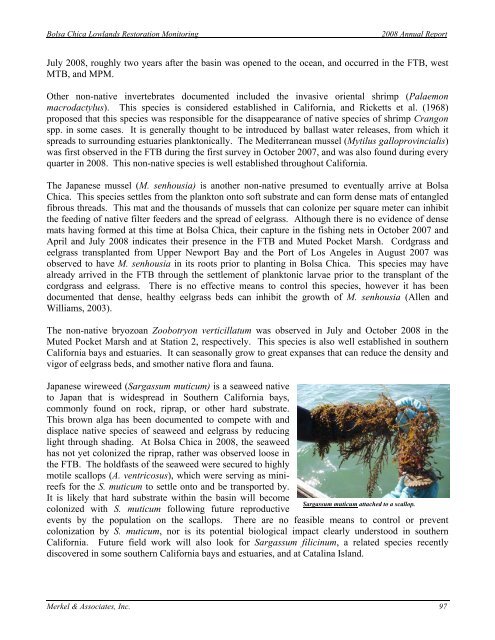2008 Annual Monitoring Report (pdf 10.9MB) - Bolsa Chica ...
2008 Annual Monitoring Report (pdf 10.9MB) - Bolsa Chica ...
2008 Annual Monitoring Report (pdf 10.9MB) - Bolsa Chica ...
You also want an ePaper? Increase the reach of your titles
YUMPU automatically turns print PDFs into web optimized ePapers that Google loves.
<strong>Bolsa</strong> <strong>Chica</strong> Lowlands Restoration <strong>Monitoring</strong><br />
<strong>2008</strong> <strong>Annual</strong> <strong>Report</strong><br />
July <strong>2008</strong>, roughly two years after the basin was opened to the ocean, and occurred in the FTB, west<br />
MTB, and MPM.<br />
Other non-native invertebrates documented included the invasive oriental shrimp (Palaemon<br />
macrodactylus). This species is considered established in California, and Ricketts et al. (1968)<br />
proposed that this species was responsible for the disappearance of native species of shrimp Crangon<br />
spp. in some cases. It is generally thought to be introduced by ballast water releases, from which it<br />
spreads to surrounding estuaries planktonically. The Mediterranean mussel (Mytilus galloprovincialis)<br />
was first observed in the FTB during the first survey in October 2007, and was also found during every<br />
quarter in <strong>2008</strong>. This non-native species is well established throughout California.<br />
The Japanese mussel (M. senhousia) is another non-native presumed to eventually arrive at <strong>Bolsa</strong><br />
<strong>Chica</strong>. This species settles from the plankton onto soft substrate and can form dense mats of entangled<br />
fibrous threads. This mat and the thousands of mussels that can colonize per square meter can inhibit<br />
the feeding of native filter feeders and the spread of eelgrass. Although there is no evidence of dense<br />
mats having formed at this time at <strong>Bolsa</strong> <strong>Chica</strong>, their capture in the fishing nets in October 2007 and<br />
April and July <strong>2008</strong> indicates their presence in the FTB and Muted Pocket Marsh. Cordgrass and<br />
eelgrass transplanted from Upper Newport Bay and the Port of Los Angeles in August 2007 was<br />
observed to have M. senhousia in its roots prior to planting in <strong>Bolsa</strong> <strong>Chica</strong>. This species may have<br />
already arrived in the FTB through the settlement of planktonic larvae prior to the transplant of the<br />
cordgrass and eelgrass. There is no effective means to control this species, however it has been<br />
documented that dense, healthy eelgrass beds can inhibit the growth of M. senhousia (Allen and<br />
Williams, 2003).<br />
The non-native bryozoan Zoobotryon verticillatum was observed in July and October <strong>2008</strong> in the<br />
Muted Pocket Marsh and at Station 2, respectively. This species is also well established in southern<br />
California bays and estuaries. It can seasonally grow to great expanses that can reduce the density and<br />
vigor of eelgrass beds, and smother native flora and fauna.<br />
Japanese wireweed (Sargassum muticum) is a seaweed native<br />
to Japan that is widespread in Southern California bays,<br />
commonly found on rock, riprap, or other hard substrate.<br />
This brown alga has been documented to compete with and<br />
displace native species of seaweed and eelgrass by reducing<br />
light through shading. At <strong>Bolsa</strong> <strong>Chica</strong> in <strong>2008</strong>, the seaweed<br />
has not yet colonized the riprap, rather was observed loose in<br />
the FTB. The holdfasts of the seaweed were secured to highly<br />
motile scallops (A. ventricosus), which were serving as minireefs<br />
for the S. muticum to settle onto and be transported by.<br />
It is likely that hard substrate within the basin will become<br />
Sargassum muticum attached to a scallop.<br />
colonized with S. muticum following future reproductive<br />
events by the population on the scallops. There are no feasible means to control or prevent<br />
colonization by S. muticum, nor is its potential biological impact clearly understood in southern<br />
California. Future field work will also look for Sargassum filicinum, a related species recently<br />
discovered in some southern California bays and estuaries, and at Catalina Island.<br />
Merkel & Associates, Inc. 97






